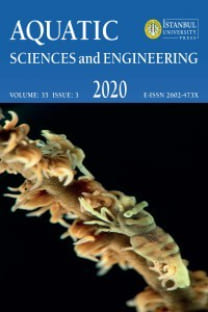EFFECT OF FROZEN WHITE WORM (Enchytraeus sp.) ON GROWTH OF PLATY (Xiphophorus maculatus Günther, 1866)
In this study, for the first time, effects of live food on platy (Xiphophorus maculatus Günther, 1866), were investigated by using frozen white worm (Enchytraeus sp.). Aquarium fish used in this study were fry with an average weight of 0.177-0.180 ±0.005 g in different groups. In the experiment, 135 fry Xiphophorus maculatus were used. Fish weights were determined, and they later were put as 15 individual in aquariums in order to breed with three different experimental feed treatments (frozen white worm, frozen white worm combined with traditional aquarium fish feed and traditional aquarium fish feed). Water temperature was determined as 23.7 ±0.05 °C in during of experiment. The fish were fed with three diet to satiation twice daily (09:00, 15:00) in during two months. In the end of the experiment average final weight was determined 0.257 ±0.01 g, 0.258 ±0.01 g and 0.211 ±0.01 g, fed on with frozen white worm, frozen white worm combined with aquarium fish feed and aquarium fish feed groups, respectively and there were significant differences between T2 (frozen white worm+combined with aquarium traditional fish feed) and T3 (aquarium traditional fish feed) groups of average final weight (p˂0.05).
Keywords:
Frozen white worm, Enchytraeus sp., Xiphophorus maculatus, growth,
___
- Dynes, R.A. (2003). Earthworms-Technological information to enable the development of earthworm production. RIRDC Publication, No. 03/085, 23 September 2003, pp. 1-3
- Gisbert, E. & Williot, P. (2002). Advances in the larval rearing of Siberian sturgeon. Journal of Fish Biology, 60, 1071-1092
- Jimenez-Rojas, J.E., Almeciga-Diaz, P.A. & Herazo-Duarte, D.M. (2012). Desempeno de juveniles del pez angel Pterophyllum scalare almentados con el oligoqueto Enchytraeus buchholzi. www.javeriana.edu.co/universitasscientiarum, 17(1), 28-34.
- Kasiri, M., Farahi, A. & Sudagar, M. (2012). Growth and reproductive performance by different feed types in fresh water angelfish (Pterophyllum scalare Schultze,1823). Veterinary Research Forum, 3(3), 175-179
- Mahfuj, M.S., Hossain, M.A. & Sarower, M.G. (2012). Effect of different feeds on larval development and survival of ornamental koi carp, Cyprinus carpio (Linnaeus, 1758) larvae in laboratory condition. Journal of Bangladesh Agricultural Universit, 10(1), 297-308
- Mandal, B., Mukherjee, A. & Banerjee, S. (2010). Growth and pigmentation development efficiencies in fantail guppy, Poecilia reticulata fed with commercially available feeds. Agriculture and Biology Journal of North America, 1(6), 1264-1267.
- Memiş, D., Çelikkale, M.S. & Ercan, E. (2004). The effect of different diets on the white worm (Enchtraeus albidus Henle, 1837) Reproduction, Turkish Journal of Fisheries and Aquatic Sciences, 4, 05-07.
- Vielma-Rondón, R., Ovalles-Duran, J.F., León-Leal, A. & Medina, A. (2003). Valor nutritivo de la harina delombriz (Eisenia foetida) como fuente de aminoácidos y su estimación cuantitativa mediantecromatografía en fase reversa (HPLC) y derivatización precolumna con o-ftalaldehído (OPA). Ars Pharmaceutica, 44(1), 43-58.
- Walsh, M.L. (2012). Examining conditioning strategies for flatfish stock enhancement to promote feeding success. Ph.D. dissertation, University of New Hampshire, Durham, NH, USA.
- Zar, J.H. (1984). Biostatistical analysis. Department of Biological Sciences, Northern IIIliois University, p. 718
- Yayın Aralığı: Yılda 4 Sayı
- Başlangıç: 1987
- Yayıncı: İstanbul Üniversitesi
Sayıdaki Diğer Makaleler
BALIK BARİYERLERİNE BİR ÖRNEK: BÜYÜKÇEKMECE BARAJI (İSTANBUL)
BALIK SAĞLIĞIYLA İLGİLİ AVRUPA BİRLİĞİ MEVZUATI VE SU ÜRÜNLERİ MÜHENDİSLİĞİ
SU ÜRÜNLERİ KOOPERATİFLERİNİN BALIKÇILIK YÖNETİMİ İÇERİSİNDEKİ ROLÜ: MARMARA DENİZİ ÖRNEĞİ, TÜRKİYE
DİP SÜRÜTME AĞLARININ BENTİK MAKROFAUNA ÜZERİNDEKİ ETKİLERİ: MARMARA VE KARADENİZ’DEKİ GÜNCEL DURUM
Mustafa ZENGİN, Hakan KAYKAÇ, Aysun GÜMÜŞ, İlkay Özcan AKPINAR
Dilek ŞAHİN, Meryem ÖZ, Zafer KARSLI, Orhan ARAL, Mehmet BAHTİYAR
